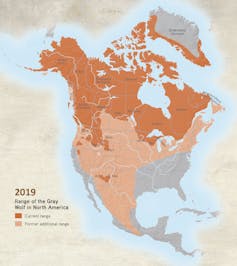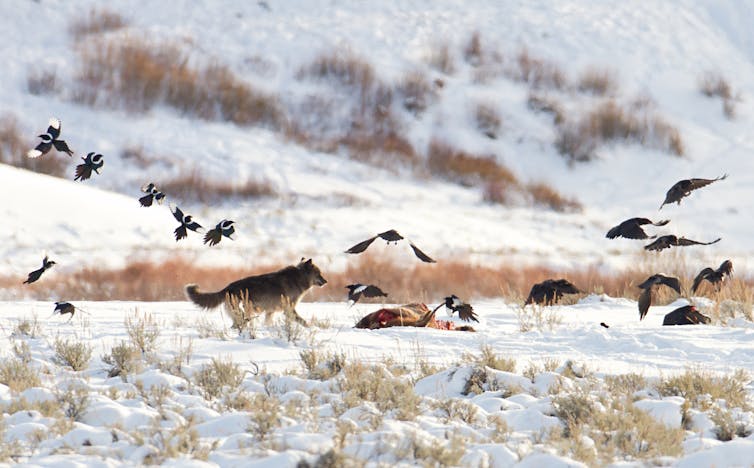Rebecca Niemiec, Colorado State University and Kevin Crooks, Colorado State University
Colorado voters will determine on Nov. 3 whether or not the state ought to reintroduce grey wolves (Canis lupus) after an almost 80-year absence. Ballot Proposition 114 would require the state to develop and oversee a science-based plan to restore wolves, centered in Western Colorado and initiated by the tip of 2023.
Restoring wolves is a contentious subject that faucets into various values and passions. Indeed, a lot of the battle surrounding wolves isn’t human versus animal, however human versus human.
Creating environments that permit people and carnivores to thrive and that decrease social battle is a world problem. Examples embody black bears and grizzly bears in North America, pumas in North and South America, wolves in Europe, lions in Africa and tigers in India.
As researchers who research the social and ecological dimensions of human-carnivore coexistence, we see the vote on Proposition 114 as a catalyst for broader discussions about carnivore conservation and administration. In our view, one of the best ways to discover workable options is to embody individuals representing all sides of the issue in shared decision-making.

Back by fashionable demand?
For 1000’s of years earlier than white settlers pushed west, grey wolves ranged all through the world that’s now Colorado, from the Western Slope and Front Range of the Rocky Mountains into the Eastern Plains. As the area was settled, authorities businesses began paying bounties for wolves and different predators that have been seen as threats to livestock and sport. By the Forties, capturing, trapping and poisoning had systematically eradicated wolves from Colorado.
In latest a long time a couple of lone wolves migrated to Colorado from adjoining states, however have been killed or just disappeared. Then, beginning in 2019, a pack of up to six wolves and a separate lone wolf have been sighted in northern Colorado. Recent media studies point out that a few of these wolves might have been shot and killed along the Wyoming-Colorado border.
Several scientific research have concluded that Colorado can nonetheless support a self-sustaining, viable wolf population. Wolves can reside efficiently in lots of varieties of habitats the place there may be sufficient prey and the place people will tolerate them.
Today grey wolves are protected in Colorado as an endangered species. However, they don’t have any authorized safety in most of Wyoming, the place they are often killed on sight. This makes it difficult for wolves to migrate from the Yellowstone area, the place they have been reintroduced in the mid-1990s, by way of Wyoming into Colorado.
The solely different adjoining states with resident wolf populations are Arizona and New Mexico, the place the endangered subspecies of Mexican grey wolf was reintroduced beginning within the Nineties. But federal policy requires that wolves leaving the reintroduction zone be recaptured and returned to it. Ultimately, then, if Coloradans need to bring wolves back, having wildlife biologists reintroduce them is the more than likely route.
Proposition 114 was positioned on the poll by way of a citizen initiative led by the Rocky Mountain Wolf Action Fund. It asserts that grey wolves are endangered in Colorado; have been traditionally an important a part of Colorado’s wildlands, however have been exterminated by people; and can help restore ecological balance if they’re reintroduced.
Wolves are predators on the prime of the meals chain. Studies from national parks recommend that wolves’ presence can produce ecological results that ripple by way of ecosystems. But science additionally tells us that such impacts are tough to predict outdoors of nationwide parks, together with in Colorado.

Clashing values
Proposition 114 has sturdy help in Colorado. Statewide surveys performed by cellphone, by mail and on-line over the previous 20 years have discovered that 66% to 84% of respondents supported reintroducing wolves. This help is constant throughout totally different areas of the state and various demographic teams.
In a survey of Colorado residents that we performed in 2019, the prospect that wolves might contribute to a balanced ecosystem was probably the most generally cited motive for supporting reintroduction. Other arguments included individuals’s cultural and emotional connections to wolves, and moral arguments that restoring a species people had eradicated was the fitting factor to do.
While general public help is robust, over half of Colorado’s 64 counties have handed resolutions against restoring wolves. Many ranching and searching associations are actively campaigning towards the poll measure.
In our 2019 research, we discovered that media protection within the state centered extra strongly on perceived negative impacts related to wolf reintroduction than on useful results. Surveys present that resident issues embody threats to human safety and pets; wolf attacks on livestock; and the potential for wolves to reduce deer and elk populations, threatening searching alternatives.
Who decides?
This measure is the primary giving voters within the U.S. a possibility to weigh in on bringing back a local species. Addressing the problem by way of a poll measure provides a novel twist to public and media discussions about wolves.
Supporters name it a democratic method to make sure that the public’s values are recognized. They additionally argue that voters are deciding solely whether or not wolves needs to be reintroduced, whereas permitting specialists on the state wildlife agency to create a reintroduction plan based on the best available science.
Opponents assert that wildlife administration selections needs to be left to state experts. As some critics be aware, the Colorado Parks and Wildlife Commission has determined against wolf reintroduction four times, most just lately in 2016. The fee is a citizen board appointed by the governor and made up of sportspersons, agricultural producers, recreationists and nonconsumptive wildlife organizations. Opponents additionally level out that individuals who don’t help reintroducing wolves, corresponding to ranchers, will bear a disproportionate share of the prices.
These arguments replicate deeper energy dynamics that affect wildlife administration throughout the U.S. Many wildlife businesses have a tendency to symbolize individuals and organizations who imagine wildlife needs to be managed for human benefit, notably searching and different consumptive makes use of.
These businesses obtain a lot of their funding from hunting and fishing license fees. And individuals who imagine wildlife needs to be managed to profit people have a tendency to help utilizing deadly strategies to management wolves and different carnivores. They are also more likely to oppose reintroducing them the place they’ve been eradicated.
However, support for this view is declining. A rising share of Americans imagine people ought to coexist with carnivores and oppose managing them primarily for human benefit. But as a result of company selections don’t all the time replicate these more and more fashionable values, individuals who advocate coexisting with nature are looking for a better say through the poll field.
[The Conversation’s science, health and technology editors pick their favorite stories. Weekly on Wednesdays.]
Finding consensus
Studies recommend that poll initiatives like 114 will become more common as public values towards wildlife change and extra various teams search to affect wildlife administration. For us, the important thing query is how to acknowledge and incorporate these differing values as businesses make selections.
Research drawing on insights from psychology, political science and sociology means that it’s essential to run truly participatory processes that interact authorities businesses and individuals who have a stake within the subject in shared decision-making. Fostering dialogue between teams that worth wildlife in another way can construct empathy and mutual understanding and foster compromise. Broadening the dialog on this method is crucial for coexisting with carnivores with minimal impacts on predators and folks.
Rebecca Niemiec, Assistant Professor within the Human Dimensions of Natural Resources, Colorado State University and Kevin Crooks, Professor of Fish, Wildlife, and Conservation Biology and Director, Center for Human-Carnivore Coexistence, Colorado State University
This article is republished from The Conversation underneath a Creative Commons license. Read the original article.







